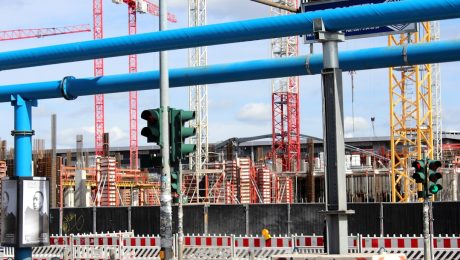Threaded pipes are ubiquitous in various industries, from plumbing and construction to manufacturing and oil and gas. Their enduring popularity stems from their versatility, reliability, and ease of installation. This comprehensive guide delves into the key features and advantages that make threaded pipes a preferred choice for countless applications.
Understanding the Mechanics of Threaded Pipe Connections
The fundamental advantage of threaded pipes lies in their connection method. Instead of relying on welds, clamps, or adhesives, threaded pipes use precisely machined threads to create a secure and leak-proof joint. These threads, typically conforming to standardized profiles like NPT (National Pipe Taper) or BSP (British Standard Pipe), ensure compatibility across different manufacturers and pipe sizes. The tapered nature of NPT threads, for instance, creates a tighter seal as the pipes are screwed together, compensating for variations in pipe alignment and ensuring a robust connection even under pressure. The process of threading itself can be done using specialized tools like pipe dies and taps, allowing for on-site assembly and modification. This contrasts with welded connections which often require specialized equipment and skilled welders.
Material Variety and its Impact on Threaded Pipe Performance
Threaded pipes are available in a wide range of materials, each offering unique properties to suit specific applications. Common materials include:
- Steel: Known for its high strength and durability, steel threaded pipes are ideal for high-pressure applications and demanding environments. Galvanized steel offers additional corrosion resistance.
- Copper: Offers excellent corrosion resistance and thermal conductivity, making it suitable for plumbing and HVAC systems. However, it’s less strong than steel.
- PVC (Polyvinyl Chloride): A lightweight and corrosion-resistant plastic material, PVC is commonly used in less demanding applications, often for drainage and irrigation systems. However, it’s not suitable for high-pressure or high-temperature applications.
- CPVC (Chlorinated Polyvinyl Chloride): A stronger and more heat-resistant variant of PVC, CPVC finds use in hot water applications and higher-pressure systems.
- Cast Iron: Offers exceptional durability and resistance to high pressure, typically used in older infrastructure and specialized applications.
The choice of material depends heavily on the intended application, considering factors like pressure, temperature, corrosive environment, and budget.
Advantages of Threaded Pipes Over Other Connection Methods
Compared to other pipe connection methods, threaded pipes offer several key advantages:
- Ease of Installation: Threaded pipes are relatively easy to install, requiring only basic hand tools in many cases. This reduces labor costs and installation time.
- Disassembly and Reassembly: Threaded connections can be easily disassembled and reassembled, making maintenance and repairs simpler and less disruptive. This is a significant advantage over welded or glued joints.
- Versatility: Threaded pipes can be used with a wide variety of fittings and valves, offering flexibility in system design and configuration.
- Leak Resistance (with proper sealing): When properly installed with appropriate thread sealant (e.g., Teflon tape), threaded connections provide excellent leak resistance, even under significant pressure.
- Cost-Effectiveness (in many cases): While the initial cost of threaded pipes might vary depending on the material, the ease of installation and maintenance often translates to overall cost savings compared to other methods.
Common Applications of Threaded Pipes
The versatility of threaded pipes makes them suitable for a wide range of applications, including:
- Plumbing Systems: Threaded pipes are widely used in residential, commercial, and industrial plumbing systems for water supply and drainage.
- Gas Lines: While requiring specific safety precautions and materials, threaded pipes are used in natural gas and propane distribution systems.
- HVAC Systems: Threaded pipes are used to transport refrigerants and other fluids in heating, ventilation, and air conditioning systems.
- Industrial Processes: Threaded pipes are crucial in transporting various fluids and gases in manufacturing, chemical processing, and other industrial settings.
- Irrigation Systems: Threaded pipes are used in irrigation systems to distribute water to crops and landscaping.
Troubleshooting and Maintenance of Threaded Pipe Systems
While generally reliable, threaded pipe systems can experience issues if not properly installed or maintained. Regular inspection for leaks is crucial. Leaks can often be addressed by tightening connections or applying additional thread sealant. In cases of significant damage or corrosion, pipe sections may need replacement. Proper use of thread sealant is paramount to prevent leaks. Using the right type and amount of sealant is critical for ensuring a watertight seal. Over-tightening connections can also damage the threads, leading to leaks or breakage. Therefore, careful installation and regular inspection are key to maintaining the integrity and longevity of threaded pipe systems.
In conclusion, the combination of robust connections, material versatility, ease of installation, and adaptability makes threaded pipes a crucial component in countless applications. Understanding their features and advantages is essential for anyone working with piping systems.
body {
font-family: sans-serif;
line-height: 1.6;
}
h1, h2, h3 {
color: #333;
}
img {
max-width: 100%;
height: auto;
display: block;
margin: 20px auto;
}
Twisted square wire, with its unique strength and aesthetic appeal, offers a surprising range of applications beyond simple binding. From intricate crafts to robust construction projects, this versatile material proves its worth in numerous ways. This comprehensive guide explores the multifaceted uses of twisted square wire, highlighting its potential in various fields.
Crafting with Twisted Square Wire: Unleashing Your Creativity
Twisted square wire’s distinct texture and strength make it an ideal material for crafting. Its relatively easy manipulation allows for intricate designs, while its durability ensures longevity. Popular applications include:
- Jewelry Making: Create unique necklaces, bracelets, and earrings by twisting and shaping the wire. Its square profile adds a modern, geometric touch. Consider incorporating beads, gemstones, or other decorative elements to enhance the design.
- Sculpting and Wire Wrapping: The wire’s rigidity lends itself well to three-dimensional sculpting. It can be easily shaped and bent to create intricate forms, either as standalone pieces or as a framework for other materials like resin or clay.
- Basket Weaving and Decorative Accents: Twisted square wire can be woven into baskets, adding a modern twist to this traditional craft. It also serves as an excellent material for creating decorative accents for home décor projects, such as picture frames or candle holders.
- Wire Wrapping of Stones and Crystals: The strong, square profile holds stones and crystals securely, creating beautiful and durable jewelry or decorative objects.
Twisted Square Wire in Construction and Industrial Applications
Beyond crafting, twisted square wire finds its place in various construction and industrial applications where strength and durability are paramount. Its resistance to bending and twisting makes it a reliable choice for:
- Reinforcement in Concrete: Used as reinforcement in concrete structures, it enhances tensile strength and durability, contributing to the overall stability of the construction. Its square shape provides a larger surface area for concrete bonding compared to round wire.
- Fence Construction and Reinforcement: Twisted square wire can be incorporated into fence construction, offering increased strength and resistance to bending or damage. It can be used as a core wire for added reinforcement within the fence structure.
- Support Structures for Gardening and Landscaping: Its strength and flexibility make it suitable for creating support structures for climbing plants or building sturdy trellises. The square profile provides excellent grip and prevents slippage.
- Binding and Packaging: Twisted square wire provides a secure and durable method for binding materials together in various industrial applications, offering superior strength compared to thinner gauges of round wire.
Choosing the Right Gauge and Material for Your Twisted Square Wire Project
The success of any project depends heavily on choosing the right type of twisted square wire. The gauge (thickness) and material dictate its strength, flexibility, and overall suitability for the task. Common materials include:
- Steel: Offers high tensile strength and durability, ideal for construction and industrial applications. It’s resistant to corrosion but can rust if not properly treated.
- Stainless Steel: Provides superior corrosion resistance, making it suitable for outdoor applications and environments with high humidity. It’s more expensive than standard steel.
- Copper: Offers excellent conductivity, making it suitable for electrical applications, although less common for crafting or structural uses in its twisted square form.
- Aluminum: Lightweight and relatively inexpensive, aluminum offers good corrosion resistance but lower tensile strength than steel.
Gauge selection depends on the project’s requirements. Thicker gauges offer greater strength but are less flexible, while thinner gauges provide more flexibility but less strength.
Safety Precautions When Working with Twisted Square Wire
While twisted square wire is a versatile material, it’s crucial to prioritize safety when working with it. Sharp edges and the potential for punctures necessitate careful handling:
- Wear protective gloves: This prevents cuts and abrasions from the wire’s sharp edges.
- Use appropriate cutting tools: Wire cutters specifically designed for the gauge of wire being used are essential to prevent bending or damaging the wire.
- Wear safety glasses: This protects your eyes from flying debris during cutting or shaping.
- Proper disposal: Dispose of wire scraps responsibly, following local regulations for metal waste.
Exploring Advanced Techniques with Twisted Square Wire
Beyond basic shaping and bending, advanced techniques can unlock even greater creative possibilities with twisted square wire. These include:
- Soldering and Welding: Joining different pieces of wire or adding decorative elements requires soldering or welding techniques, depending on the wire material.
- Hammering and Texturing: Hammering can create interesting textures and patterns on the wire, adding visual interest to crafts.
- Patina Application: Applying a patina can enhance the wire’s aesthetic appeal, creating aged or antique effects.
- Combination with Other Materials: Integrating twisted square wire with other materials like wood, beads, or resin opens up a world of mixed-media possibilities.
Experimentation and practice are key to mastering these advanced techniques and unlocking the full potential of twisted square wire.
With its strength, versatility, and aesthetic appeal, twisted square wire is a material brimming with possibilities. From intricate crafts to robust construction projects, its applications are as diverse as your imagination.
SEO Tags:
twisted square wire, square wire uses, wire crafts, construction wire, metal wire
The choice between concrete and steel is a fundamental decision in any construction project. Both materials are incredibly strong and versatile, but they possess distinct properties that make them suitable for different applications. This in-depth comparison will explore the strengths and weaknesses of each, helping you understand which material is best suited for your needs.
Strength and Durability: A Head-to-Head Comparison
Concrete, a composite material made from cement, aggregates, and water, excels in compressive strength. This means it can withstand significant crushing forces. Steel, on the other hand, boasts superior tensile strength, meaning it can resist stretching and pulling forces. In terms of durability, both materials offer longevity, but their susceptibility to different types of damage varies. Concrete is vulnerable to cracking under tensile stress and can be susceptible to freeze-thaw damage in colder climates. Steel, while incredibly strong, is prone to corrosion if not properly protected. The longevity of both materials is heavily reliant on proper design, construction, and maintenance.
Cost Analysis: Balancing Budget and Performance
The cost of concrete and steel varies depending on several factors, including location, availability, and market conditions. Generally, concrete is often considered a more cost-effective option for large-scale projects like foundations and massive structures. The initial cost of steel can be higher, especially for complex designs requiring intricate fabrication. However, steel’s lighter weight can sometimes lead to reduced transportation and erection costs. Furthermore, the long-term maintenance costs associated with corrosion protection for steel need to be factored into the overall budget. A thorough cost-benefit analysis is crucial before making a material selection.
Structural Applications: Where Each Material Shines
Concrete’s compressive strength makes it ideal for foundations, retaining walls, and columns. Its ability to be cast into various shapes allows for flexibility in design. Steel, with its high tensile strength, is frequently used in beams, girders, and frameworks, especially in high-rise buildings and long-span structures. The combination of both materials, known as composite construction, is often employed to leverage the strengths of each. For instance, steel reinforcement within concrete (rebar) significantly improves its tensile strength and crack resistance, creating a highly robust composite structure.
Environmental Impact: Sustainability Considerations
The environmental impact of both concrete and steel production is significant. Cement production, a key component of concrete, releases substantial amounts of carbon dioxide into the atmosphere. Steel production also has a large carbon footprint, primarily due to the energy-intensive process of smelting iron ore. However, both materials can be incorporated into sustainable building practices. Using recycled materials in concrete production, employing low-carbon cement alternatives, and optimizing steel designs to minimize material usage can significantly reduce the environmental impact. Life cycle assessments are increasingly important in evaluating the overall sustainability of building materials.
Maintenance and Lifespan: Long-Term Considerations
The long-term performance of both concrete and steel structures depends heavily on proper maintenance. Concrete requires periodic inspection for cracks and damage, potentially necessitating repairs or surface treatments. Steel structures need regular protection against corrosion through painting, galvanizing, or other protective coatings. The lifespan of both materials can be extended significantly with appropriate maintenance programs. Neglecting maintenance can lead to premature deterioration and costly repairs or even structural failure. Therefore, a well-defined maintenance plan should be integral to any construction project using either concrete or steel.
Ultimately, the choice between concrete and steel depends on the specific requirements of the project. Factors such as budget, structural demands, environmental considerations, and maintenance capabilities should all be carefully weighed. Often, the most effective approach involves a hybrid solution, combining the strengths of both materials to create a robust and cost-effective structure.
SEO Tags: concrete, steel, construction materials, structural design, building construction
The global steel industry is a behemoth, characterized by complex supply chains, international trade, and significant financial transactions. Navigating this landscape requires sophisticated financial instruments and a deep understanding of trade finance tools. This comprehensive guide explores the key tools available to facilitate smooth and secure steel trading, mitigating risks and optimizing profitability for all stakeholders.
1. Letters of Credit (LCs): The Cornerstone of Steel Trade Security
Letters of credit are arguably the most crucial trade finance instrument in the steel industry. They provide a high level of security for both buyers and sellers. An importer (buyer) obtains an LC from their bank, guaranteeing payment to the exporter (seller) upon presentation of specific documents proving shipment and compliance with the contract terms. This eliminates much of the credit risk inherent in international trade. In the steel sector, where transactions often involve large sums and complex specifications, LCs offer crucial risk mitigation. Different types of LCs, such as irrevocable, confirmed, and transferable LCs, can be tailored to the specific needs of a steel trade transaction, further enhancing security and flexibility.
2. Documentary Collections: A Simpler, Cost-Effective Alternative
Documentary collections represent a simpler and often less expensive alternative to LCs. While they don’t offer the same level of payment guarantee, they still provide a structured framework for handling documents and payment. The exporter ships the goods and presents the required documents (bill of lading, commercial invoice, certificate of origin, etc.) to their bank, which forwards them to the importer’s bank. Payment is then released upon the importer’s acceptance of the documents. This method is suitable for established trading relationships where a higher degree of trust exists, or for smaller transactions where the cost of an LC may be prohibitive. In the steel industry, documentary collections are frequently used for transactions between parties with a proven track record.
3. Factoring: Streamlining Receivables and Improving Cash Flow
Factoring involves selling your accounts receivable (invoices) to a specialized financial institution (factor) at a discounted rate. This provides immediate access to cash, improving cash flow and reducing the reliance on bank financing. For steel producers and traders, factoring can be particularly beneficial in managing the extended payment terms often associated with large steel contracts. By selling invoices to a factor, businesses can accelerate their cash cycle, enabling them to reinvest in operations, purchase raw materials, and meet their financial obligations more efficiently. This is especially crucial in a volatile market like steel, where timely access to capital can be the difference between success and failure.
4. Supply Chain Finance: Optimizing the Entire Steel Supply Chain
Supply chain finance (SCF) encompasses a range of financial solutions designed to optimize the entire supply chain, from raw material procurement to final product delivery. This can involve early payment programs for suppliers, extended payment terms for buyers, and other innovative financing structures. In the steel industry, SCF can significantly enhance efficiency and collaboration among various players, including steel mills, traders, distributors, and end-users. By improving cash flow throughout the supply chain, SCF reduces working capital requirements, minimizes financing costs, and strengthens relationships between trading partners. This is particularly relevant given the intricate and geographically dispersed nature of the global steel supply chain.
5. Risk Mitigation Strategies in Steel Trade Finance: Navigating Market Volatility
The steel market is notoriously volatile, subject to price fluctuations, geopolitical events, and supply chain disruptions. Effective risk mitigation is therefore paramount in steel trade finance. This involves a multifaceted approach, including careful due diligence on trading partners, robust contract negotiation, appropriate insurance coverage (e.g., cargo insurance, credit insurance), and the strategic use of trade finance instruments like LCs and guarantees. Hedging strategies, such as using futures contracts or options, can also help mitigate price risk. A comprehensive risk management framework is essential for navigating the complexities of the steel market and ensuring the financial stability of businesses involved in steel trading.
In conclusion, successful navigation of the steel trade landscape requires a thorough understanding and strategic application of various trade finance tools. By leveraging these instruments effectively, businesses can mitigate risks, optimize cash flow, and foster stronger relationships with their trading partners. The tools discussed above offer a solid foundation for securing and streamlining transactions within this dynamic and essential industry.
In the demanding world of industrial machinery, standardized components often fall short. When performance needs are critical, and off-the-shelf solutions simply won’t suffice, the answer lies in customized steel machine parts. This comprehensive guide delves into the design, manufacturing, and benefits of these crucial components, highlighting why they are essential for optimizing machinery performance and longevity.
1. Designing for Success: The Art of Custom Steel Machine Part Design
The design phase is paramount. It’s where the foundation for a high-performing, durable part is laid. This involves a collaborative process between engineers and clients, carefully considering the specific application, required tolerances, anticipated stresses, and operating environment. Factors like temperature fluctuations, corrosive elements, and the level of required precision must all be meticulously factored into the design. Advanced computer-aided design (CAD) software plays a crucial role, allowing for detailed 3D modeling, simulations, and stress analysis to ensure the part meets the intended specifications before even a single piece of steel is cut. This upfront investment in design prevents costly rework and ensures a superior final product. Specific design considerations might include:
- Material Selection: Choosing the appropriate steel alloy (e.g., stainless steel, high-carbon steel, alloy steel) based on strength, corrosion resistance, and cost-effectiveness.
- Tolerance Levels: Defining the acceptable deviation from the specified dimensions to guarantee precise functionality within the machine.
- Surface Finish: Specifying the desired surface roughness to optimize performance and prevent wear and tear.
- Heat Treatments: Determining necessary heat treatments to enhance strength, hardness, or other properties.
2. Precision Manufacturing: From Blueprint to Reality
Once the design is finalized, the manufacturing process begins. This often involves a combination of advanced techniques to ensure accuracy and quality. Common methods include:
- CNC Machining: Computer Numerical Control machining utilizes sophisticated software and automated machinery to precisely cut, shape, and finish steel parts to exacting specifications. This offers high precision and repeatability.
- Forging: This process involves shaping the metal using compressive forces, resulting in a part with superior strength and grain structure compared to casting.
- Casting: Molten steel is poured into a mold to create the desired shape. This method is suitable for complex geometries but may require additional machining for precise dimensions.
- Welding: Used to join different steel components or repair damaged parts. Advanced welding techniques ensure strong, reliable joints.
- Additive Manufacturing (3D Printing): Emerging technologies like 3D printing are increasingly used for prototyping and producing complex steel parts with intricate designs.
Quality control measures are implemented throughout the manufacturing process, ensuring adherence to design specifications and the highest standards of quality.
3. Steel Alloys: Choosing the Right Material for the Job
The selection of the appropriate steel alloy is critical for the performance and longevity of the customized part. Different steel alloys offer varying properties, including:
- Strength: High-carbon steels offer exceptional strength, while other alloys provide a balance of strength and ductility.
- Corrosion Resistance: Stainless steels are renowned for their resistance to rust and corrosion, making them ideal for harsh environments.
- Hardness: Certain alloys can be heat-treated to achieve exceptional hardness, improving wear resistance.
- Weldability: The ease with which a steel can be welded is crucial for assembling complex components.
- Machinability: Some alloys are easier to machine than others, impacting manufacturing cost and efficiency.
Careful consideration of these properties ensures the chosen steel alloy perfectly matches the specific demands of the application.
4. Applications Across Industries: Where Customized Steel Parts Shine
Customized steel machine parts find applications across a vast range of industries. Their versatility and adaptability make them indispensable in:
- Automotive: High-strength steel components for chassis, engines, and transmissions.
- Aerospace: Lightweight yet incredibly strong steel alloys for aircraft components.
- Energy: Durable steel parts for power generation equipment and oil & gas infrastructure.
- Construction: Heavy-duty steel components for cranes, excavators, and other construction machinery.
- Manufacturing: Precision steel components for automated production lines and industrial machinery.
In each application, customized parts offer superior performance, precision, and longevity compared to standard components.
5. The Benefits of Choosing Custom Steel Machine Parts
Investing in customized steel machine parts offers several significant advantages:
- Enhanced Performance: Parts are designed specifically for the application, optimizing performance and efficiency.
- Increased Durability: Careful material selection and robust design lead to longer lifespan and reduced downtime.
- Improved Reliability: Precision manufacturing minimizes the risk of failure and ensures consistent operation.
- Cost Savings in the Long Run: While initial costs may be higher, the increased lifespan and reduced maintenance translate to long-term cost savings.
- Tailored Solutions: Custom parts address unique requirements, solving problems that standard components cannot.
Ultimately, the investment in customized steel machine parts represents a commitment to quality, reliability, and long-term success.
Choosing a reputable supplier with expertise in design and manufacturing is crucial for ensuring the success of your project. Partnering with a skilled team ensures that your custom steel machine parts meet the highest standards of quality and performance.
Tags: customized steel machine parts, bespoke steel components, steel fabrication, precision machining, industrial parts
The construction of ports and harbors is a complex undertaking, requiring robust and durable materials capable of withstanding the harsh marine environment. Increasingly, steel pipes are emerging as a game-changing solution, offering a unique blend of strength, flexibility, and cost-effectiveness. This blog post delves into the fascinating world of port construction with steel pipes, exploring the design considerations, installation processes, advantages, challenges, and future prospects of this innovative approach.
1. Design Considerations for Steel Pipe Port Structures
Designing a port structure using steel pipes necessitates careful consideration of several factors. The diameter and wall thickness of the pipes are crucial, determined by the anticipated loads, water depth, and soil conditions. Finite element analysis (FEA) is often employed to simulate the structural behavior under various loading scenarios, including wave forces, seismic activity, and vessel impacts. The design must also account for corrosion protection, employing techniques like galvanization, coating, or cathodic protection to extend the lifespan of the structure. Furthermore, the design should incorporate ease of assembly and maintenance, minimizing downtime and operational costs. Modular designs, using prefabricated pipe sections, are becoming increasingly popular, speeding up construction and reducing on-site work.
2. Installation Techniques for Steel Pipe Port Components
The installation of steel pipe port structures can be carried out using various methods, depending on the water depth, site conditions, and the type of structure being built. For shallow water, pipes can be driven directly into the seabed using specialized equipment. In deeper water, divers or remotely operated vehicles (ROVs) might be employed to guide the pipes into position. Specialized barges and cranes are often used to handle and position the large and heavy pipe sections. Welding plays a critical role in connecting the pipe sections, requiring skilled welders and stringent quality control measures to ensure structural integrity. The use of specialized underwater welding techniques may be necessary for deep-water installations. Precise alignment and accurate welding are paramount to prevent leaks and ensure the structural stability of the entire port facility.
3. Advantages of Utilizing Steel Pipes in Port Construction
Steel pipes offer several compelling advantages in port construction. Their high strength-to-weight ratio allows for the construction of robust structures with minimal material usage, reducing costs and environmental impact. The flexibility of steel pipes allows them to adapt to uneven seabed conditions, simplifying the construction process and reducing the need for extensive site preparation. Steel pipes are also highly durable and resistant to corrosion when properly protected, ensuring a long service life. Furthermore, the modular nature of steel pipe structures facilitates easy expansion and modification, accommodating future growth and changing port requirements. The prefabrication aspect also allows for much of the construction to be completed off-site, minimizing disruption at the construction site.
4. Challenges and Mitigation Strategies in Steel Pipe Port Projects
Despite the numerous advantages, challenges exist in steel pipe port construction. Corrosion remains a major concern, requiring robust protection measures to prevent degradation. The transportation and handling of large-diameter pipes can pose logistical difficulties, especially in remote locations. Ensuring accurate alignment and welding underwater can be technically demanding and requires specialized expertise. Environmental considerations, such as potential impacts on marine life and seabed habitats, must be carefully addressed through proper planning and mitigation strategies. Finally, the need for skilled labor and specialized equipment can impact project costs and timelines. Careful planning, rigorous quality control, and the adoption of innovative construction techniques are essential to overcome these challenges.
5. Future Trends and Innovations in Steel Pipe Port Technology
The future of steel pipe port construction is bright, with ongoing innovation driving improvements in design, materials, and construction techniques. The development of high-strength, corrosion-resistant steel alloys is enhancing the durability and lifespan of these structures. Advanced simulation tools and digital twin technologies are improving design accuracy and reducing construction risks. The integration of sensors and monitoring systems allows for real-time assessment of structural health and early detection of potential problems. Furthermore, the increasing use of automation and robotics in construction is streamlining the installation process and improving efficiency. Research into sustainable construction practices, including the use of recycled steel and minimizing environmental impacts, is also gaining momentum.
In conclusion, steel pipe port construction represents a significant advancement in coastal infrastructure development. By leveraging the inherent strengths of steel pipes and addressing the associated challenges through innovative solutions, this approach offers a sustainable, cost-effective, and efficient way to build robust and resilient ports for the future.
SEO Tags:
- Steel pipe port construction
- Offshore port construction
- Marine infrastructure
- Steel pipe applications
- Sustainable port development
Structural steel has long been a cornerstone of modern construction, and for good reason. Its versatility, strength, and efficiency make it a preferred material for architects and engineers worldwide. This comprehensive guide delves into the compelling benefits of using structural steel, highlighting why it remains a top choice for a wide range of projects, from skyscrapers to bridges and industrial facilities.
Unmatched Strength and Durability: The Foundation of Resilience
Perhaps the most obvious benefit of structural steel is its exceptional strength-to-weight ratio. Steel possesses a remarkable ability to withstand significant loads and stresses, making it ideal for supporting heavy structures and resisting extreme weather conditions. This inherent strength translates into durable buildings that can withstand the test of time, requiring less maintenance and offering a longer lifespan compared to other materials. Furthermore, steel’s resilience against seismic activity and high winds makes it a crucial component in earthquake-prone regions and areas susceptible to hurricanes or typhoons. The ability to withstand these extreme forces makes structural steel a safer and more reliable building material.
Versatility and Design Flexibility: Shaping Architectural Visions
Steel’s versatility is another key advantage. Its malleability allows for intricate designs and complex shapes, offering architects unparalleled freedom of expression. Unlike concrete or timber, steel can be easily fabricated into various profiles, including beams, columns, and trusses, accommodating a vast array of architectural styles and functional requirements. This flexibility extends to the construction process itself. Steel structures can be prefabricated off-site, significantly reducing on-site construction time and minimizing disruptions. This prefabrication also allows for greater precision and quality control, leading to faster project completion and reduced overall costs.
Cost-Effectiveness and Efficiency: Optimizing Construction Budgets
While the initial cost of steel may seem higher than some materials, its overall cost-effectiveness becomes apparent when considering the entire lifecycle of a building. The speed of construction, reduced labor costs due to prefabrication, and the long lifespan of steel structures contribute to significant long-term savings. Moreover, the efficiency of steel construction minimizes material waste, contributing to a more sustainable and environmentally responsible approach. The reduced construction time also translates to faster project completion, allowing for quicker occupancy and faster return on investment.
Sustainability and Environmental Responsibility: Building a Greener Future
Contrary to common misconceptions, structural steel is a remarkably sustainable material. Steel is 100% recyclable, and the recycling process consumes significantly less energy than producing virgin steel. This inherent recyclability contributes to a circular economy, minimizing the environmental impact of construction. Furthermore, advancements in steel production are continuously improving its environmental profile, with a focus on reducing carbon emissions and promoting sustainable manufacturing practices. Steel structures also contribute to energy-efficient buildings through their ability to incorporate advanced insulation techniques and design features.
Ease of Fabrication and Installation: Streamlining the Construction Process
Steel’s ease of fabrication and installation is a significant benefit that contributes to faster project completion and reduced labor costs. The precise and repeatable nature of steel fabrication allows for pre-engineered components to be manufactured off-site, reducing on-site work and improving overall efficiency. The use of standardized connections and readily available tools further simplifies the installation process, minimizing the need for specialized labor and accelerating project timelines. This efficiency translates to cost savings and a more streamlined construction process, leading to faster project delivery and quicker occupancy.
In conclusion, the benefits of structural steel are undeniable. From its unparalleled strength and durability to its versatility, cost-effectiveness, and sustainability, steel remains a superior choice for a wide range of construction projects. Its ability to shape architectural visions, streamline construction processes, and contribute to a greener future solidifies its position as a leading material in the construction industry for years to come.
SEO-Friendly Tags:
- Structural Steel
- Steel Construction
- Steel Building Materials
- Sustainable Steel Construction
- Benefits of Structural Steel
Offering a wide product range can be a double-edged sword. While it presents significant opportunities for growth and market share expansion, it also introduces complexities in inventory management, marketing, and customer experience. This comprehensive guide explores the intricacies of managing a diverse product portfolio, outlining the advantages, challenges, and strategies for success.
The Allure of Diversification: Benefits of a Wide Product Range
A wide product range offers several compelling advantages. Firstly, it reduces reliance on a single product or market segment. If one product underperforms, others can compensate, mitigating risk and ensuring business stability. Secondly, it allows businesses to cater to a broader customer base, attracting individuals with diverse needs and preferences. This expanded reach translates to increased market share and revenue potential. Thirdly, a diverse portfolio allows for cross-selling and upselling opportunities. Customers purchasing one product are more likely to be interested in related items, leading to higher average order values. Finally, a wide range can enhance a company’s brand image and perception, positioning it as a comprehensive and reliable provider within its industry.
Inventory Management: The Juggling Act of a Diverse Portfolio
Managing inventory for a wide product range is a significant challenge. Efficient inventory management requires robust systems to track stock levels, predict demand, and optimize storage space. Demand forecasting becomes crucial; inaccurate predictions can lead to stockouts of popular items or excess inventory of slow-moving products. Implementing a Just-in-Time (JIT) inventory system or a similar strategy can help minimize storage costs and reduce waste. Furthermore, investing in Inventory Management Software (IMS) can automate many tasks, providing real-time visibility into inventory levels and facilitating better decision-making. Regular inventory audits and analysis are essential to identify slow-moving items and adjust purchasing strategies accordingly.
Marketing Strategies for a Multifaceted Product Offering
Marketing a wide product range requires a strategic approach that goes beyond simple mass marketing. Segmentation and targeting are key; dividing the target audience into distinct groups based on demographics, needs, and preferences allows for more effective and personalized messaging. Different marketing channels might be suitable for different product categories. For example, social media might be ideal for reaching younger demographics interested in trendy products, while print advertising could be more effective for reaching older consumers interested in more established brands. Product categorization and clear messaging are vital to avoid overwhelming customers. Organizing products logically and highlighting key features and benefits for each item makes it easier for customers to navigate the product range and find what they need.
Customer Experience: Personalization and Seamless Navigation
Providing a positive customer experience is paramount when offering a wide product range. A well-designed website with robust search functionality, clear product descriptions, and high-quality images is essential. Customers should be able to easily find the products they’re looking for, compare options, and make informed purchasing decisions. Personalized recommendations, based on past purchases or browsing history, can enhance the shopping experience and drive sales. Excellent customer service, including multiple channels for support (e.g., phone, email, chat), is crucial for resolving issues and building customer loyalty. Gathering customer feedback through surveys and reviews allows businesses to identify areas for improvement and tailor their offerings to customer needs.
Scaling and Growth: Strategies for Expanding a Diverse Product Range
Expanding a wide product range requires careful planning and execution. Market research is crucial to identify potential new product categories and assess market demand. Thorough product development ensures that new products meet customer needs and expectations. Building strong supplier relationships is vital for securing reliable sourcing and maintaining consistent product quality. Strategic partnerships can facilitate expansion into new markets or product categories. Finally, constantly monitoring key performance indicators (KPIs), such as sales figures, customer satisfaction, and inventory turnover, provides valuable insights for optimizing the product range and maximizing profitability. Regular review and analysis enable businesses to adapt to changing market conditions and ensure the continued success of their diverse product portfolio.
Managing a wide product range presents unique challenges, but the potential rewards are significant. By implementing effective strategies for inventory management, marketing, and customer experience, businesses can harness the power of diversification to achieve sustainable growth and market leadership.
SEO-Friendly Tags:
- Wide Product Range
- Product Diversification Strategy
- Inventory Management for Diverse Products
- Marketing a Wide Product Portfolio
- Customer Experience with Diverse Products
body {
font-family: sans-serif;
line-height: 1.6;
}
h1, h2, h3 {
color: #333;
}
h1 {
font-size: 2.5em;
}
h2 {
font-size: 2em;
}
h3 {
font-size: 1.5em;
}
The phrase “000 ton/year production capacity” represents a significant milestone for any manufacturing or industrial operation. This seemingly simple figure encapsulates a complex interplay of factors, ranging from raw material sourcing and processing to logistical considerations and market demand. This post delves into the intricacies of this capacity level, exploring its implications and the challenges it presents.
Understanding the Significance of 000 Ton/Year Production
A production capacity of 000 tons per year signifies a substantial output, the exact implications of which depend heavily on the specific industry and product. For some industries, this might represent a relatively small-scale operation, while for others, it could be a massive undertaking. The significance lies in the scale of operations required to achieve this level of production. It necessitates significant investments in infrastructure, equipment, personnel, and management systems. This level of production often necessitates advanced planning, efficient resource allocation, and rigorous quality control measures to maintain consistent output and meet market demands.
Scaling Challenges Associated with 000 Ton/Year Production
Scaling to a 000 ton/year production capacity presents unique challenges. Simply increasing the number of machines or employees isn’t sufficient. Effective scaling requires a holistic approach addressing several key areas:
- Infrastructure: Adequate facility space, power supply, and transportation infrastructure are crucial. Expansion might require significant capital investment in new buildings, machinery, and storage facilities.
- Supply Chain Management: Securing a consistent supply of raw materials at competitive prices becomes paramount. This often involves establishing strong relationships with suppliers and implementing robust inventory management systems.
- Technology and Automation: Optimizing production processes through automation and advanced technologies is essential to maintain efficiency and productivity at this scale. This could involve implementing robotics, sophisticated control systems, and data analytics tools.
- Human Resources: Managing a larger workforce requires effective recruitment, training, and retention strategies. Clear communication channels and a well-defined organizational structure are crucial for efficient teamwork and coordination.
Market Impact and Demand Forecasting for 000 Ton/Year Output
Achieving a 000 ton/year production capacity necessitates a clear understanding of market demand. Accurately forecasting demand is critical to avoid overproduction or shortages. Market research, competitor analysis, and trend identification are all vital components of this process. Entering a new market with this level of production capacity requires a robust marketing and sales strategy to reach and acquire new customers. Understanding pricing strategies and distribution channels is equally important to effectively penetrate the market and maintain profitability.
Optimizing Efficiency and Reducing Costs at 000 Ton/Year
Maintaining profitability at this production scale demands meticulous attention to efficiency and cost reduction. Several strategies can be employed:
- Lean Manufacturing Principles: Implementing lean manufacturing techniques, such as eliminating waste and streamlining processes, can significantly improve efficiency and reduce costs.
- Inventory Management: Efficient inventory management minimizes storage costs and prevents stockouts. Just-in-time inventory systems can be highly effective.
- Energy Efficiency: Reducing energy consumption through the use of energy-efficient equipment and processes can lead to substantial cost savings.
- Waste Management: Implementing effective waste management strategies reduces disposal costs and minimizes environmental impact.
- Process Optimization: Continuous monitoring and improvement of production processes through data analysis and process optimization techniques are essential to maintain peak efficiency.
Sustainability and Environmental Considerations at Scale
Producing at a 000 ton/year capacity necessitates a strong commitment to sustainability and environmental responsibility. This includes minimizing waste, reducing energy consumption, and responsibly managing resources. Compliance with environmental regulations and adopting eco-friendly practices are not just ethical considerations but also essential for long-term business viability. Investing in renewable energy sources, implementing recycling programs, and reducing carbon emissions are crucial steps toward sustainable production at this scale.
In conclusion, achieving a 000 ton/year production capacity is a significant undertaking that requires careful planning, strategic investment, and a commitment to operational excellence. By addressing the challenges of scaling, market dynamics, efficiency optimization, and sustainability, businesses can unlock the full potential of this impressive production level and achieve long-term success.
Tags: Production Capacity, Manufacturing, Scaling, Efficiency, Sustainability, Market Demand, Industrial Production
Pipe bending and straightening are crucial processes in various industries, from construction and manufacturing to oil and gas. Achieving precise bends and ensuring straightness is essential for functionality, safety, and aesthetics. This comprehensive guide delves into the different methods, equipment, and considerations involved in mastering these techniques.
1. Understanding Pipe Bending Techniques: A Variety of Approaches
Pipe bending techniques are diverse, each suited to different pipe materials, diameters, and desired bend radii. The most common methods include:
- Manual Bending: This involves using hand tools like pipe benders for smaller diameter pipes. It’s suitable for smaller-scale projects and requires significant manual dexterity and strength. However, accuracy can be challenging, and it’s not suitable for large-diameter or thick-walled pipes.
- Hydraulic Bending: Hydraulic pipe benders utilize hydraulic pressure to bend pipes accurately and efficiently. This method is preferred for larger diameter pipes and allows for precise control over the bend radius. The versatility of hydraulic benders makes them suitable for various pipe materials.
- Rotary Draw Bending: This technique uses a rotating die and a clamping mechanism to pull the pipe through, creating a smooth, consistent bend. It’s often used for high-precision applications and minimizes the risk of pipe deformation or wall thinning.
- Roll Bending: Roll bending machines use three rollers to progressively bend the pipe. This method is ideal for creating large radius bends in long lengths of pipe and is commonly used in the manufacturing of large structures.
- Induction Bending: This method uses localized heating through induction to soften the pipe material before bending, allowing for tighter bends with less risk of cracking. It’s particularly useful for high-strength alloys that are difficult to bend using other methods.
2. Pipe Straightening Methods: Rectifying Imperfections
Pipes can become bent or misaligned during transportation, handling, or installation. Straightening methods aim to restore the pipe’s original straightness. Common techniques include:
- Manual Straightening: For minor bends, manual straightening using hammers and mallets might suffice. This method is labor-intensive and requires skill to avoid causing further damage to the pipe.
- Hydraulic Straightening Presses: These presses use hydraulic power to apply controlled force to straighten the pipe. They are more efficient and precise than manual straightening, handling larger and more severely bent pipes.
- Roll Straighteners: Similar to roll benders, roll straighteners use rollers to progressively straighten the pipe. They are effective for long lengths of pipe with multiple bends.
- Three-Roll Straightening Machines: These machines utilize three adjustable rollers to apply controlled pressure to straighten the pipe. They offer high precision and are suitable for a wide range of pipe diameters and materials.
3. Choosing the Right Equipment: Factors to Consider
Selecting the appropriate bending or straightening equipment depends on several factors:
- Pipe Material: Different materials (steel, copper, aluminum, etc.) have varying properties that influence the bending and straightening methods and equipment required.
- Pipe Diameter and Wall Thickness: Larger diameter and thicker-walled pipes require more powerful equipment.
- Desired Bend Radius: The desired bend radius dictates the type of bending equipment needed. Tighter bends require specialized techniques and equipment.
- Production Volume: For high-volume production, automated equipment is more efficient than manual methods.
- Budget: Equipment costs vary significantly, from simple hand tools to sophisticated automated machines.
4. Safety Precautions: Prioritizing Safety in Pipe Manipulation
Pipe bending and straightening can be hazardous if proper safety precautions aren’t taken. Essential safety measures include:
- Personal Protective Equipment (PPE): Always wear appropriate PPE, including safety glasses, gloves, and hearing protection.
- Proper Machine Operation: Thoroughly understand the operation of any equipment before use and follow all manufacturer’s instructions.
- Safe Work Practices: Maintain a clean and organized workspace, ensure proper ventilation, and avoid distractions.
- Emergency Procedures: Be prepared for emergencies and know how to respond to potential hazards.
- Regular Equipment Maintenance: Regularly inspect and maintain equipment to ensure safe and efficient operation.
5. Applications Across Industries: Where These Techniques Shine
Pipe bending and straightening are indispensable in a wide array of industries:
- Construction: Creating pipe networks for plumbing, heating, and cooling systems.
- Manufacturing: Producing components for various machinery and equipment.
- Oil and Gas: Constructing pipelines for transporting oil and gas.
- Automotive: Manufacturing exhaust systems and other components.
- Aerospace: Creating components for aircraft and spacecraft.
- Furniture Manufacturing: Creating custom metal furniture pieces.
Understanding the nuances of pipe bending and straightening, coupled with the selection of appropriate equipment and adherence to safety protocols, is crucial for successful project completion across diverse industrial applications. By carefully considering the factors outlined above, professionals can ensure efficient, precise, and safe manipulation of pipes, leading to high-quality results.
Tags: pipe bending, pipe straightening, hydraulic bending, pipe bending machine, pipe straightening equipment










